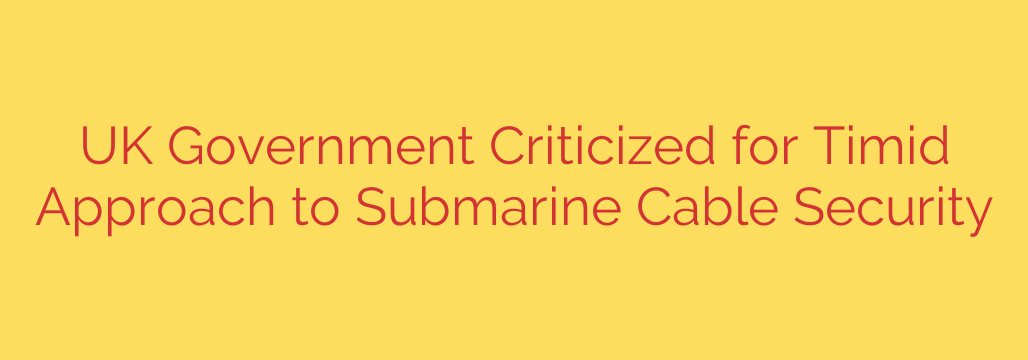
The Hidden Threat: Why UK Submarine Cable Security is a National Priority
In our hyper-connected world, the internet is as essential as electricity or water. We rely on it for everything from banking and communication to national defence and healthcare. But the physical foundation of this digital reality—a vast network of undersea cables—is alarmingly vulnerable, and serious questions are being raised about whether the UK is doing enough to protect it.
These submarine cables are the invisible backbone of the global economy. An estimated 97% of all global communications and over $10 trillion in daily financial transactions are transmitted through these fibre-optic wires laid across the ocean floor. For an island nation like the United Kingdom, they are not just important; they are the country’s digital lifeline. A significant disruption could cripple the economy, sever international communications, and pose a grave threat to national security.
A Growing Web of Threats Lurking Beneath the Waves
The dangers facing this critical infrastructure are both complex and growing. While accidental damage from fishing trawlers and ship anchors has always been a concern, the more sinister threat of deliberate sabotage is now a primary focus for security experts.
Key threats to UK subsea cables include:
- State-Sponsored Sabotage: Hostile states possess the naval and technical capabilities to covertly sever or tap into these cables. Such an act, especially during a time of heightened geopolitical tension, could be a devastating form of “grey-zone” warfare, designed to destabilize the nation without engaging in conventional conflict.
- Espionage: The cables are not just conduits for public internet traffic; they carry sensitive government, military, and corporate data. Tapping these lines offers a priceless intelligence opportunity for adversaries.
- Terrorism: Non-state actors could also target these relatively unprotected assets to cause widespread chaos and economic damage. The cables often land in predictable, publicly known locations, making them potential targets.
Is the UK’s Response Sufficient?
Despite the clear and present danger, a consensus is emerging that the UK’s approach to protecting this vital infrastructure has been too slow and fragmented. While the government has taken some steps, including commissioning a new multi-role ocean surveillance ship to monitor the seabed, critics argue these measures fall short of what is urgently required.
Concerns have been raised at the highest levels, with parliamentary committees issuing stark warnings about the nation’s preparedness. The core of the criticism focuses on several key areas:
- A Lack of a Unified Strategy: Responsibility for cable security is spread across multiple government departments, including the Home Office, the Ministry of Defence, and the Department for Science, Innovation and Technology. This siloed approach risks creating gaps in security and slows down effective decision-making. A clear, overarching national strategy is seen as a critical missing piece.
- Over-Reliance on the Private Sector: The vast majority of these cables are owned and operated by private telecommunications and tech companies. While these firms are responsible for maintenance, they do not have the resources or mandate to defend against state-level military threats. Experts argue that the government has been too passive, failing to establish clear security standards or a robust partnership with industry.
- Insufficient Resources: Protecting thousands of miles of cables across a vast expanse of the seabed is a monumental task. A single surveillance ship is considered a good first step, but it is far from an adequate deterrent or a comprehensive defence. More investment in naval assets, seabed monitoring technology, and intelligence gathering is deemed essential.
Actionable Steps for a More Resilient Digital Future
Securing the UK’s subsea network requires a decisive and coordinated effort. Waiting for a catastrophic incident to occur is not an option. A robust security plan should be built on the following principles:
- Develop a Cohesive National Strategy: The government must appoint a single lead department or minister to oversee all aspects of submarine cable security. This would streamline communication, clarify responsibilities, and ensure a unified and proactive approach.
- Strengthen Public-Private Partnerships: Legislation should be created to mandate minimum security standards for cable operators. In return, the government should provide better intelligence sharing, resources, and a clear framework for how the Royal Navy and other state assets will protect this private infrastructure.
- Invest in Surveillance and Defence: The UK must enhance its maritime surveillance capabilities. This includes not only more ships but also investing in advanced technologies like autonomous underwater drones and sophisticated sensor networks to monitor critical cable corridors.
- Promote Route Diversity and Resilience: Encouraging the construction of new cable routes can reduce the impact of a single cable being cut. Building redundancy into the network is one of the most effective ways to mitigate risk.
Ultimately, the security of our undersea cables is synonymous with the security of the nation. As our reliance on digital infrastructure deepens, the consequences of inaction grow more severe. It is time to move beyond a timid approach and take the bold, strategic steps necessary to protect the United Kingdom’s connection to the world.
Source: https://go.theregister.com/feed/www.theregister.com/2025/09/29/submarine_cable_security_report_uk/








